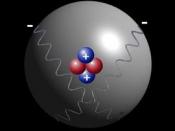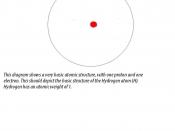When Hydrogen is heated to the extent that it glows, it produces bars of colored light that appear at certain wav lengths. This spectrum of atomic hydrogen may be obtained by heating the hydrogen to the point of which the molecule breaks apart into individual atoms. Even though Hydrogen is the most basic of gasses, it has the ability to produce more than one hundred different colors. When a substance produces a spectrum of light, the pattern and colors displayed are unique to that substance, however it is universal for every substance of the same element.
The Danish physicist by the name of Neil Bohr presented a set of rules in 1913 in regards to the orbit of electrons around the nucleus of an atom. Bohr proposed that electrons had a path they must follow while orbiting the nucleus called a "shell." He proposed that with in this "shell" were a specified amount of electrons.
He thought that the innermost shell would contain two electrons and the second and third would each contain eight. The electrons would then occupy the innermost shell before filing into the next outer shell. No further attempts were made to further his studies and produce reasons fo his model of the atom nor prove his hypothesis.
This new model of an atom provided a sturdy explanation for the spectrum of light emitted from a energized atom. When an atom is give any form of energy, the electrons jump from shell to shell. If the energy was released from the atom, the electrons would return to their natural position on their original cell. A band of colored light is given off with the movement of electrons from the outer shells to the original shell. The color of the light is determined by the distance at...


